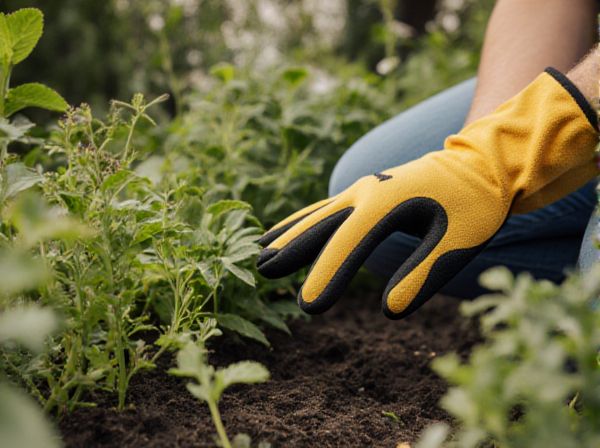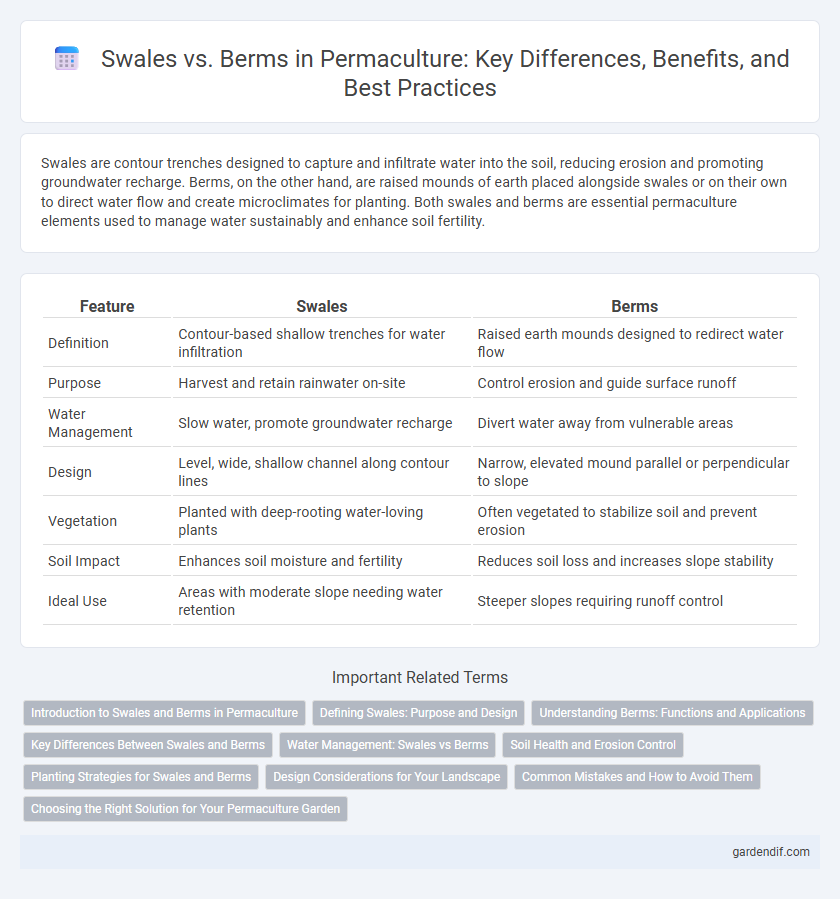
Swales vs Berms Illustration
Swales are contour trenches designed to capture and infiltrate water into the soil, reducing erosion and promoting groundwater recharge. Berms, on the other hand, are raised mounds of earth placed alongside swales or on their own to direct water flow and create microclimates for planting. Both swales and berms are essential permaculture elements used to manage water sustainably and enhance soil fertility.
Table of Comparison
| Feature | Swales | Berms |
|---|---|---|
| Definition | Contour-based shallow trenches for water infiltration | Raised earth mounds designed to redirect water flow |
| Purpose | Harvest and retain rainwater on-site | Control erosion and guide surface runoff |
| Water Management | Slow water, promote groundwater recharge | Divert water away from vulnerable areas |
| Design | Level, wide, shallow channel along contour lines | Narrow, elevated mound parallel or perpendicular to slope |
| Vegetation | Planted with deep-rooting water-loving plants | Often vegetated to stabilize soil and prevent erosion |
| Soil Impact | Enhances soil moisture and fertility | Reduces soil loss and increases slope stability |
| Ideal Use | Areas with moderate slope needing water retention | Steeper slopes requiring runoff control |
Introduction to Swales and Berms in Permaculture
Swales are key permaculture earthworks designed to capture and slow water runoff by digging contour-aligned trenches that infiltrate water into the soil. Berms are raised mounds or ridges formed from the excavated soil, typically positioned downslope of swales to retain moisture and create microclimates for plants. Together, swales and berms enhance water management, soil fertility, and ecosystem resilience in permaculture design.
Defining Swales: Purpose and Design
Swales are landscape features designed to capture and slow water runoff, promoting infiltration and reducing erosion on slopes. Typically constructed as shallow, contoured trenches on contour lines, swales direct water into the soil, enhancing moisture retention for vegetation and improving overall site hydrology. Their purpose is to create microclimates that support plant growth, increase groundwater recharge, and mitigate the impacts of drought in permaculture systems.
Understanding Berms: Functions and Applications
Berms are raised soil mounds designed to manage water flow, prevent erosion, and create microclimates within permaculture systems. They function by capturing rainwater runoff, slowing its movement to enhance infiltration and plant hydration, which supports sustainable landscape management. Applications of berms include contour gardening, stormwater control, and habitat creation, making them essential for efficient water conservation in permaculture design.
Key Differences Between Swales and Berms
Swales are contour-following trenches designed to capture and infiltrate water into the soil, enhancing moisture retention and reducing erosion. Berms are raised mounds or embankments created from the displaced soil of swales, acting as barriers to slow water flow and support plant growth through improved drainage. The primary difference lies in swales functioning as water catchment features, while berms serve as structural supports and elevation changes within permaculture landscapes.
Water Management: Swales vs Berms
Swales are shallow, broad channels designed to capture and slowly infiltrate rainwater into the soil, reducing erosion and improving groundwater recharge. Berms are raised mounds of earth placed downstream of swales or contour lines to redirect water flow and prevent runoff. Combining swales and berms in permaculture enhances water retention, soil moisture stability, and landscape resilience against drought and flooding.
Soil Health and Erosion Control
Swales enhance soil health by capturing and infiltrating water, promoting deep root growth and microbial activity, which reduces erosion by slowing runoff on contour lines. Berms act as raised barriers on the downhill side of swales, stabilizing soil further by redirecting water flow and preventing surface runoff from washing away topsoil. Together, swales and berms create a synergistic system that optimizes water retention and soil stabilization, crucial for sustainable land management in permaculture.
Planting Strategies for Swales and Berms
Swales promote deep water infiltration by capturing runoff along contour lines, making them ideal for planting drought-tolerant, deep-rooted species such as native grasses and nitrogen-fixing trees. Berms, elevated ridges beside swales, support moisture-loving plants that thrive in well-drained soil, including herbs, shrubs, and vegetables requiring consistent moisture. Combining swales and berms optimizes microclimates, allowing strategic placement of diverse crops for improved water efficiency and soil health in permaculture systems.
Design Considerations for Your Landscape
Swales and berms play distinct roles in permaculture design, with swales acting as water catchment ditches constructed on contour lines to slow runoff and enhance groundwater recharge. Berms, on the other hand, are raised mounds of soil that guide water flow and create microclimates for planting. Effective landscape design requires careful analysis of site topography, soil type, and water flow patterns to determine the optimal combination and placement of swales and berms for maximizing water retention and soil fertility.
Common Mistakes and How to Avoid Them
Common mistakes in swales include improper placement on slopes, causing water to either overflow or pool excessively, and failure to compact the soil adequately, reducing water retention. Berm errors often involve incorrect sizing or steepness, leading to erosion and reduced stability. Avoid these issues by conducting thorough site assessments, designing swales to follow contour lines precisely, and constructing berms with gradual slopes and appropriate vegetation for erosion control.
Choosing the Right Solution for Your Permaculture Garden
Swales and berms serve distinct functions in permaculture design, with swales primarily used to capture and infiltrate water on contour, reducing erosion and enhancing soil moisture, while berms act as raised barriers to direct runoff and support plantings. Selecting the right solution depends on site topography, soil type, and rainfall patterns, where swales are ideal for gentle slopes with moderate to high rainfall and berms suit steeper areas needing water diversion. Effective integration of swales and berms optimizes water management, promoting sustainable growth and resilience in permaculture gardens.
Swales vs Berms Infographic

 gardendif.com
gardendif.com